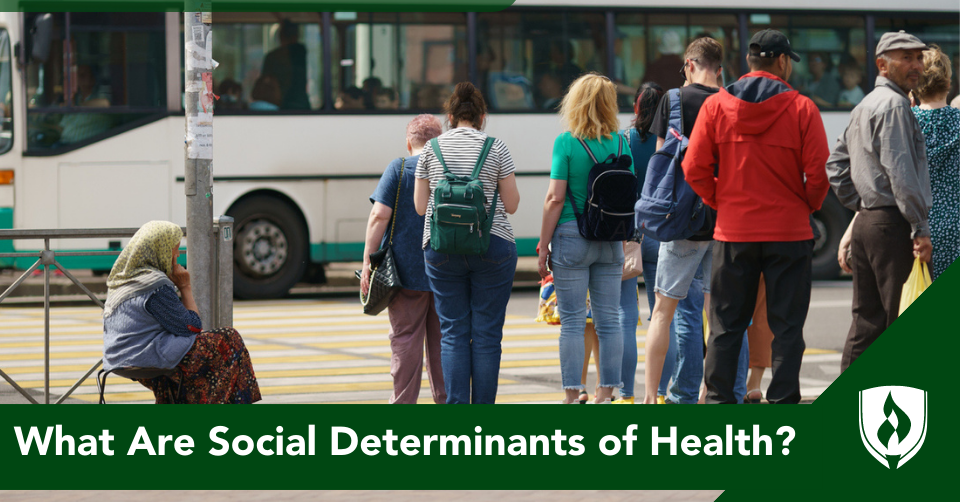
It may be cliché to attribute superpowers to nurses, but when addressing social determinants of health, perhaps it has never been more appropriate.
What if the ultimate villain lurks in the shadows of healthcare, in each and every exam room, like an invisible puppeteer, stealthily shaping health like the mischievous conductor of a grand symphony?
Without close attention, even healthcare workers might not notice these shaping forces, though their impacts manifest in all sorts of symptoms. Social determinants of health (SDoH) bury themselves so deep in our lives that we may never get a close look at them. But nurses and healthcare workers all over are trying to draw these forces to the forefront of medical consideration.
"Understanding social determinants of health is crucial to our practice because it allows us to view our patients in a holistic way, going beyond just their physiological symptoms,” says RN BSN Nurse Carlin Longley. “Our role extends beyond providing direct care. We are also educators, advocates and intermediaries for our patients."
When you can identify the impacts of SDoH on health outcomes and how to address them—you can work as an advocate for better, more comprehensive care.
Read on to gain a better understanding of this critical topic and to get some ideas on what nurses can do about it.
What are social determinants of health?
Social determinants of health are the environmental conditions in which individuals are born, grow, work, play and age, greatly influencing a broad spectrum of health outcomes, functioning and overall quality of life.1
You can think of them as “the aspects of our lives that seem to only indirectly affect our health, but statistically determine the likelihood of poor health and outcomes,” according to nurse anesthetist and CRNA, Nick Angelis.
SDoH can shape the fortunes of patients. From cultural biases that perpetuate inequities, to social isolation or economic disparities that throw a wrench into education and healthcare access, social determinants of health can sicken and harm people even before a virus or contagion takes hold.
Why do nurses need to understand social determinants of health?
Social determinants of health are very important because they remind us that our well-being isn't just about our personal choices or medical treatments. They shine a light on the role of social, economic and environmental factors and how they shape health disparities (health status) and overall well-being. Your health isn’t just about what you do, it’s also about where you live, your income and the incomes of people around you. It’s about how you are perceived by your society, what communities you belong to and who trusts or doesn’t trust you. It’s about education—not just yours, but your parents’ and even their parents’ access.
By understanding the significance of social determinants and their impact, nurses can adopt a holistic approach and tailor their health services to address the root causes of the inequities they come across, whenever possible.
Nurses can work towards creating a fair and just healthcare system where health equity isn't just a pipe dream. The American Nurses Association (ANA) writes, "health equity is essential: People should be able to be healthy and thrive in every community—not just some."
The impact of social determinants on health disparities
The World Health Organization (WHO) says social determinants of health play a significant role in influencing health disparities. These determinants, rooted in social, economic and environmental factors, can create unequal opportunities and circumstances that impact the health outcomes for many people and populations.
For instance, limited access to quality education and employment opportunities can lead to lower income and socioeconomic status, which in turn affects access to healthcare, nutrition and other resources necessary for good health.2
Imagine two people with identical medical circumstances. One of them lives in a community with lots of education and job opportunities. They have stable employment and health insurance. The other person lacks education opportunities and needs to bounce from job to job as they make ends meet. They don’t have health insurance, and need to deal with the regular stressors of employment change and financial instability, making it harder for them to spend time on their health.
These two otherwise similar people will likely wind up with massive differences in their health over time. Money, stability, insurance and access to professionals who can teach you about your health can stave off many different illnesses, catch diseases early and give you options in how best to care for yourself.
At the bottom line, the circumstances of our lives hugely affect our health.
When populations face barriers and inequities, they are more likely to experience health disparities, with higher rates of chronic diseases, poorer health and reduced life expectancy.2
The 5 domains of social determinants of health and their implications
Each social determinant factor form an intricate web of cause and effect, bleeding into each other.
According to the U.S. Department of Health and Human Services, social determinants of health can be classified into five distinct groups or domains:
- Economic Stability
- Education Access and Quality
- Health Care Access and Quality
- Neighborhood and Built Environment
- Social and Community Context
1. Economic stability
The economic domain focuses on factors such as income, employment, poverty and social support that influence an individual's financial security and stability.
Examples of economic factors:
- Income
- Employment
- Healthcare services (therapies, screenings, etc.)
- Education
Economic status has a profound impact on people's health. Those with higher economic status tend to experience better overall health and lower rates of chronic diseases compared to those with lower economic status.
For example, individuals with higher economic status often have greater access to healthcare services, including preventative care, timely screenings and specialized treatments. They also have the financial means to afford necessary medications and therapies.3
Also, economic status influences living conditions, such as access to safe housing, nutritious food options and access to recreational facilities. Families and individuals with lower economic status often face environmental challenges, such as living in areas with higher pollution levels or limited access to fresh water and healthy food.
Education also plays a role. The American Psychological Association (APA) points out, the higher your socioeconomic status, the better your education is likely to be. And to extend it a bit further, higher levels of education are associated with better health knowledge, healthier behaviors and improved decision-making regarding healthcare.4 Therefore, families from lower economic statuses who have less education, also have less health knowledge and fewer health resources, performing fewer healthy behaviors.
Additionally, economic status affects stress levels, with financial hardships, job insecurity and limited resources leading to chronic stress. Prolonged exposure to stress can negatively impact physical and mental health, increasing the risk of various health conditions.
2. Education
Education acts as a powerful determinant of a person's health, playing a crucial role in the outcome of a patient's well-being.
Examples of education factors:
- Literacy and health literacy
- Educational attainment
- Access to education
- Educational opportunities
Health knowledge and awareness: Health literacy and education equip patients with knowledge about health-related topics, such as disease prevention, healthy lifestyle choices and understanding of healthcare information. Again, higher levels of education are associated with higher health literacy, enabling individuals to make informed decisions about their well-being.
Health behaviors: Education plays a crucial role in shaping health behaviors. Health behaviors are the choices and actions people make that have an impact on their well-being and mortality. Regular physical exercise, balanced nutrition and avoiding risky behaviors like smoking or substance abuse all fit in this category.
Access to healthcare: Education can impact access to healthcare services. Patients with higher education levels tend to have greater knowledge about healthcare systems, insurance coverage and resources available to them. This knowledge enables them to navigate the healthcare system more effectively, access timely medical care and engage in preventative health measures.
Economic status: Higher education levels are often associated with higher income and better job prospects. Improved economic status provides people with financial resources to afford healthcare, secure safe housing, access nutritious food and engage in health-promoting activities.
Social and emotional well-being: Education can enhance social and emotional well-being, which in turn positively affects overall health. Education provides individuals with skills, confidence and opportunities for personal growth, leading to improved self-esteem, resilience and improved mental health outcomes.
Employment opportunities: Higher education levels open a broader range of employment opportunities. Stable employment with adequate income and benefits positively impacts health by providing financial security, access to healthcare coverage and a sense of security.
3. Healthcare access and quality
The National Library of Medicine defines access to healthcare as, "having timely use of personal health services to achieve the best possible health outcome.”
The healthcare access and quality domain encompasses factors like healthcare coverage, access to healthcare services, availability of primary care and the quality of healthcare received, all of which significantly impact health outcomes and disparities. Here's how they influence each other:
Examples of Healthcare access and quality factors:
- Health insurance
- Healthcare costs (affordability)
- Availability of healthcare facilities
- Provider shortages
- Continuity of care
Timeliness of care: Easy and timely access to healthcare services is essential for preventing and treating illnesses effectively. When people have prompt access to healthcare providers, they can receive timely screenings, diagnoses and treatments. Timely care can then mean early detection of health conditions, improved management of chronic diseases and better overall patient outcomes.
Continuity of care: Access to consistent and continuous healthcare services supports and promotes better patient outcomes. When individuals can establish a long-term relationship with a primary care provider, they benefit from coordinated and comprehensive care. That continuity allows for better health management.
Preventive services: Access to preventive healthcare services, like vaccinations and screenings, is crucial for early disease detection and prevention. Adequate access to preventive care helps identify potential health risks, enabling timely interventions to mitigate or prevent the progression of diseases.
Treatment effectiveness: Healthcare quality directly impacts treatment effectiveness. Access to high-quality healthcare services, evidence-based treatments and skilled medical professionals ensures that individuals receive appropriate and effective care. When patients have good experiences with their providers, they also are more likely to follow those providers’ care plans and open up about health concerns.
4. Neighborhood and built environment
“Environment affects health more than individual behaviors," according to The National Academy of Medicine (NAM). Sure, maintaining good health is a personal responsibility, but your choices only stretch as far as your options. And not everyone has open, green spaces to get outside, places to exercise, nearby grocery stores and nutritious meal options.
If you live in a neighborhood without a grocery store and lack reliable transportation, or if the grocery options near you don’t have much in the way of fresh produce or if everything is too expensive, healthy meal choices become far more difficult. Air quality in your home might be totally out of your control, and consistent exposure to pollution or contaminants can harm you over time.
When it comes to health, many individuals face uphill battles due to their living conditions. Nurses who understand this can ask about a patient’s home environment before drafting a care plan and maybe even brainstorm solutions.
Examples of neighborhood and built environment factors:
- Housing quality
- Neighborhood safety
- Access to healthy food
- Transportation infrastructure
- Air and water quality
Here are some of this domain's implications on health systems, inequities and population health:
Access to healthcare facilities: The proximity and availability of healthcare facilities within a neighborhood directly affects healthcare outcomes. When patients have easy access to hospitals, clinics and primary care providers, they are more likely to seek timely medical care, receive preventive services and manage their health conditions effectively.
Environmental hazards: The presence of environmental hazards, such as air pollution, toxic waste sites or inadequate sanitation in a neighborhood can negatively impact health outcomes. Exposure to these hazards increases the risk of respiratory diseases, allergies and other health issues.
Safety and crime rates: Neighborhood safety and crime rates can influence healthcare outcomes. High crime rates and unsafe neighborhoods may discourage community members from outdoor activities or commuting for groceries and exercise, leading to sedentary lifestyles and an increased risk of obesity and chronic diseases.
Safety also has a huge impact on mental health.
Built environment and physical activity: The design of the built environment plays a role in shaping physical activity levels and by extension, an individual's health. Neighborhoods with well-maintained sidewalks, bike lanes and parks encourage active lifestyles and promote physical fitness. Conversely, neighborhoods lacking these features may discourage physical activity.
5. Social and community context
The social and community domain considers social norms, social networks, values, community support and resources and the level of community cohesion, as these factors greatly influence population outcomes and access to resources.
Examples of social and community context factors:
- Discrimination and marginalization
- Cultural and language barriers
- Social integration
- Community engagement and participation
Relationships and interactions with family, friends, colleagues and community can significantly influence overall health and well-being. Here's a closer look:
Social norms and behaviors: Communities with positive health norms, where healthy behaviors are encouraged and supported, tend to have better health outcomes. Conversely, communities with unhealthy norms, such as high rates of tobacco use or unhealthy eating habits, can contribute to negative health outcomes.
Addressing social norms and promoting health-positive behaviors within communities is essential for improving healthcare outcomes.
Social support: Individuals with supportive relationships, whether through family, friends or community organizations, often experience improved mental well-being, better adherence to treatment plans and increased engagement in behaviors that promote health.
Cultural factors: Culturally competent care considers the unique needs, preferences and perspectives of individuals from different cultural backgrounds, leading to improved communication, better treatment adherence and enhanced healthcare outcomes. Nurses who understand social determinants of health will better navigate cultural differences in their patient communities—and recognize the importance of learning about them.
Practical ways to identify and assess social determinants of health in clinical settings
For nurses, the key is to create a supportive and non-judgmental environment where patients feel comfortable discussing their social circumstances. Let the focus remain on health promotion and patient education—but understand the vast oceans of significance all these other factors have in your patients’ lives.
By incorporating the following approaches, nurses and other health professionals can gain a better understanding of patients' overall well-being and tailor their care to address both the medical and social aspects that influence health.
Here are some ideas…
- Use screening tools: Use simple questionnaires or surveys to ask patients about their social circumstances. These tools can cover topics like income, education, housing, food, transportation and support systems. They help gather valuable information about patients' lives beyond their medical conditions.
- Seek training: Pursue training on the importance of SDoH and how to discuss them with patients. Teach them to ask sensitive questions and create a comfortable environment for patients to share their social needs. Cultural sensitivity training is also valuable to ensure respectful, inclusive assessments.
- Update electronic health records (EHR): Integrate SDOH assessment results into electronic health record systems to easily document relevant social information during patient visits, monitor outcomes, track progress and evaluate intervention effectiveness. EHR prompts or templates can make it simpler to gather comprehensive SDoH data, and ongoing evaluation and improvement processes only enhance the impact of SDoH assessments.
- Collaborate with social service providers: Nurses can find ways to work with other health professionals, community organizations and social service providers. Build networks for referrals, so your patients can access resources and support services that address their social needs. This collaboration enhances the holistic care patients receive beyond medical treatments.
- Educate patients: Inform your patients about the significance of SDoH and how it can impact their health. Provide them with resources and information about community services, support networks and available resources.
- Data sharing and research: Partner with public health agencies, researchers and policymakers to share quality SDoH data. This data can contribute to research, policy development and targeted interventions to address social determinants on a larger scale.
How nursing impacts social determinants of health today
Nurses, as frontline healthcare providers, are well-positioned to address social determinants of health due to their close interactions with patients and their thorough training.
Here are some ways in which nurses contribute directly to addressing social determinants of health:
Assessment and screening: Nurses already have training to assess patients comprehensively, including identifying social determinants of health that may impact their well-being. They use screening tools and interviews to gather information about social factors such as housing, education, income, social support and access to healthcare.
Advocacy and referral: Nurses also advocate for their patients' social needs and refer them to relevant community resources and support services. They may already collaborate with social workers, community organizations and other healthcare providers to ensure patients have access to social support networks, affordable housing, food assistance programs, employment services, transportation and other resources.
Education and empowerment: Education is a huge part of being a nurse. Nurses can empower patients to make informed decisions, navigate healthcare systems and access available resources. By promoting health literacy, nurses help individuals better understand and address their social needs.
Care coordination: Nurses play a crucial role in coordinating care for patients, particularly those with complex social needs. They collaborate with interdisciplinary teams to develop care plans that address both the medical and social aspects of patients' well-being. This coordination involves connecting patients with community resources, scheduling follow-up appointments and ensuring continuity of care.
Policy advocacy: Nurses have a unique perspective and voice in advocating for policy changes that address social determinants of health. Nurses can engage in policy discussions and advocate for equitable access to healthcare, affordable housing, quality education and other social determinants.
Research and evidence-based practice: Nurses also contribute to research efforts focused on social determinants of health and their impact on patient outcomes. They can participate in studies, collect data and analyze findings to generate evidence that informs nursing practice.
The most important things for nurses to understand about SDoH
All of the above is definitely a lot of information. But according to Alice Benjamin, APRN, MSN, ACNS-BC FNP-C, CCRN, CEN, CV-BC and correspondent for Nurse.org, nurses need to understand a few important takeaways most:
Social determinants of health are multi-faceted in nature
Social determinants of health encompass a wide range of factors, including economic, social and environmental aspects that influence individual and community well-being. These are interconnected and have a cumulative effect on health.
Social determinants contribute to health inequities
resulting in disparities in health outcomes among different population groups. Recognizing and addressing these inequities is essential for achieving health equity.
Nurses and other healthcare providers have a crucial role
It’s hard to imagine having an impact on things as massive as SDoH, but nurses really can make a difference through assessment, advocacy and interventions to improve health outcomes and reduce health disparities.
Addressing social determinants of health requires collaboration
Don’t try to work alone here. Real progress comes when healthcare professionals, policymakers, community organizations and patients themselves work together. “Advocacy efforts are necessary to create systemic changes that promote health equity,” Benjamin says.
Social determinants of health and nursing education
The nursing profession has been tasked to lead the health equity revolution, and it starts in the classroom. Nursing education curricula includes teaching various strategies and approaches to address SDoH.
Here are some of the key areas that nurses might focus on during their nursing programs:
- SDoH education
- Health advocacy
- Cultural competence
- Collaboration and referrals
- Health policy
Nursing in and for your community
As we've uncovered the profound impact of social determinants of health on patient well-being, it remains crystal clear that nurses play a crucial role in the battle against these disparities.
We need all the help we can get. If this initiative has you fired up and you want to learn more ways you can directly serve your community as a nurse, check out our article What Is Community Health Nursing? Examining This Important Role.
1Healthy People 2030. U.S. Department of Health and Human Services. Social Determinants of Health. Date accessed 6/10/23. https://health.gov/healthypeople/priority-areas/social-determinants-health
2National Academies of Sciences, Engineering, and Medicine; Health and Medicine Division; Board on Population Health and Public Health Practice; Committee on Community-Based Solutions to Promote Health Equity in the United States. The State of Health Disparities in the United States. Date accessed: 6/11/23. https://www.ncbi.nlm.nih.gov/books/NBK425844/
3Caballo B, et al. International Socioeconomics Laboratory. The Effects of Socioeconomic Status on the Quality and Accessibility of Healthcare Services. Date accessed 6/10/23. https://projects.iq.harvard.edu/files/isl/files/the_effects_of_socioeconomic_status_on_the_quality_and_accessibility_of_healthcare_services.pdf
4Center on Society and Health. Why Education Matters to Health: Exploring the Causes. Date accessed 6/10/23. https://societyhealth.vcu.edu/work/the-projects/why-education-matters-to-health-exploring-the-causes.html#gsc.tab=0




